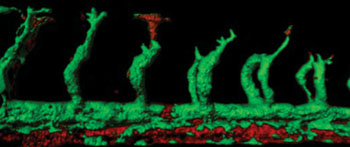Research on Zebrafish Embryos Reveals Origin of the Lymphatic System
By LabMedica International staff writers
Posted on 04 Jun 2015
A team of developmental biologists working with a zebrafish embryo model system has located the site of origin of the lymphatic system and identified a gene critical to the differentiation of stem cells into mature lymphatic cells.Posted on 04 Jun 2015
Investigators at the Weizmann Institute of Science (Rehovot, Israel) exploited the transparent bodies of zebrafish embryos to document development in real time over a period of several days. By reversing the direction of the video images, they were able to determine that the cells giving rise to lymphatic vessels always originated in a niche of angioblasts localized at the same part of the embryo's major vein.

Image: Zebrafish embryos with fluorescent blood vessels helped solve the mystery regarding the origin of the lymphatic system (Photo courtesy of the Weizmann Institute of Science).
Zooming in to the molecular level, the investigators identified the Wnt5b protein as a novel lymphatic inductive signal in the zebrafish embryos and further showed that it promoted the "angioblast-to-lymphatic" transition in human embryonic stem cells as well. Wnt5b in humans is encoded by the WNT5B (Wingless-type MMTV integration site family, member 5B) gene. The WNT gene family consists of structurally related genes that encode secreted signaling proteins. These proteins have been implicated in oncogenesis and in several developmental processes, including regulation of cell fate and patterning during embryogenesis.
Writing in the May 20, 2015, online edition of the journal Nature, the investigators reported that addition of Wnt5b to cultures of human embryonic stem cells induced those cells to differentiate into lymphatic cells—possibly the first time such cells had been grown in a laboratory.
"We started out by imaging zebrafish, and ended up finding a factor that makes it possible to create lymphatic cells," said senior author Dr. Karina Yaniv, assistant professor of biological regulation at the Weizmann Institute of Science. "That is the beauty of research in developmental biology: The embryo holds the answers, and all we have to do is watch and learn."
Related Links:
Weizmann Institute of Science







 Analyzer.jpg)





